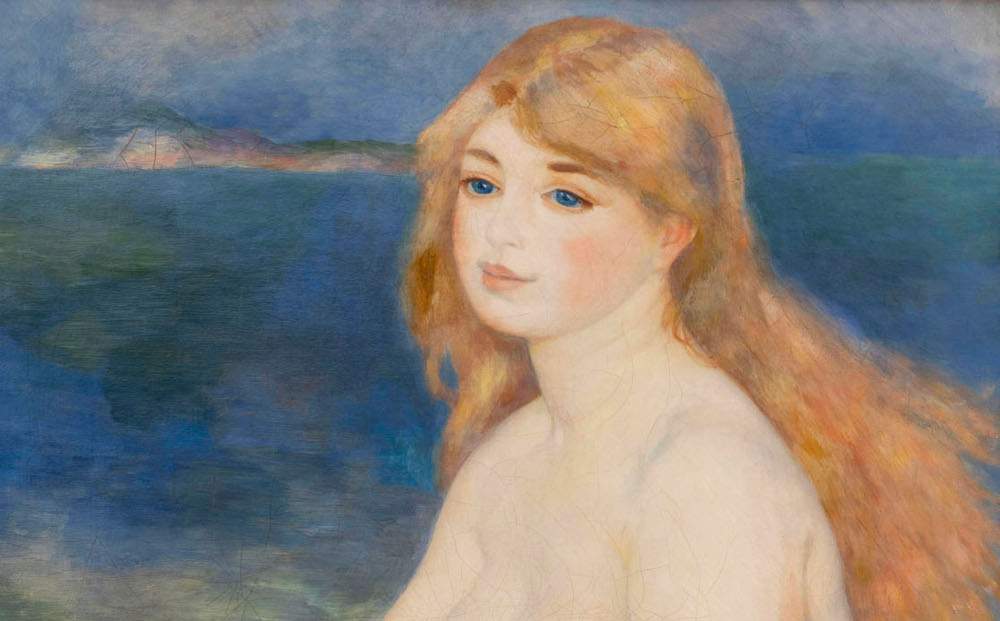How did Renoir's painting change after his trip to Italy? An exhibition in Rovigo on the non-impressionist Renoir
From Feb. 25 to June 25, 2023, Palazzo Roverella in Rovigo is hosting the exhibition Pierre-Auguste Renoir: the Dawn of a New Classicism, curated by Paolo Bolpagni.
Of Renoir, among the greatest exponents ofImpressionism, the moment after the brief Impressionist experience, when the artist, driven by a deep creative restlessness, decided to undertake a trip to Italy in 1881, will be analyzed through the exhibition. The tour began in Venice, where he was impressed above all by Carpaccio and Tiepolo (he was already well acquainted with Titian and Veronese, whom he admired and studied in the Louvre); the journey then continued by brief stops in Padua and Florence, and finally in Rome. Here Renoir developed an admiration for the Renaissance masters. Another stop on the trip was the Gulf of Naples: Renoir discovered Pompeian paintings, was enraptured by the beauty of the island of Capri and the ancient masterpieces on display in the archaeological museum. Finally he went to Palermo, where he met Richard Wagner and portrayed him in a work that became famous.
The trip to Italy, rather than provoking works of particular note, caused a kind of creative revolution in the artist that influenced his later production, culminating in hisabandonment of Impressionist technique and poetics.
From the joie de vivre of the amusement scenes of the Parisian bourgeoisie of the 1970s, Renoir thus switched to a harsh style. Also taking up the lesson of Jean-Auguste-Dominique Ingres, the painter, then in his early forties, recovered a sharp stroke and a focus on the volumetries and monumentality of the figures, in the name of a synthesis that focused on a personal form of classicism, while the dominant trends were moving toward Postimpressionism on the one hand and Symbolism on the other. In the first two decades of the twentieth century, Renoir then moved on to create art that constituted, as the avant-garde movements were being unleashed, an early harbinger of the new sensibility that would become dominant after the World War, painting in a neo-Renaissance style, where warm, shimmering tones borrowed from Titian and Rubens were combined with references to a mythical, classical iconography and an exaltation of the poetics of family affection. Renoir thus anticipated various aspects of the rappel à l’ordre-a side worthy of focus, since what superficially appeared to not a few as an involution was, in fact, a foreshadowing of much of the painting and sculpture that would develop between the wars.
The exhibition will therefore focus in particular on this second phase of Renoir’s career, beginning with his return from his trip to Italy and ending with the works of his old age, initially highlighting proximities and tangencies with Giuseppe De Nittis, Federico Zandomeneghi, Giovanni Boldini, and Medardo Rosso, Italians active in Paris, and then highlighting theoriginality of a production that constituted one of the earliest instances that “modern classicism” that would be pursued by numerous artists of the 1920s and 1930s in Italy, as will be highlighted by the dialogues that will be created in the rooms of Palazzo Roverella. For example, with sculptures by Marino Marini and Antonietta Raphaël (flanked by Renoir’s Venus Victrix of 1916), and with paintings by Armando Spadini, Carlo Carrà, Giorgio de Chirico, Arturo Tosi, Filippo de Pisis, Luigi Bartolini, and Enrico Paulucci.
The focus will then be placed on Pierre-Auguste Renoir’s production from the 1880s onward, which marked the beginning of a gradual departure from the Impressionist experience. The exhibition will then follow the evolution of his painting in subsequent developments, from the classical and “neo-Renaissance” monumentality of the figures to the landscapes of Provence and the Côte d’Azur, investigating both the relationships with other artists and the “assonances” with those who, in the period of the “return to order,” meditated on and assimilated his lesson. In the exhibition, the path will start from a masterpiece of Renoir’s Impressionist season, the large preparatory oil-on-canvas study of the famous Moulin de la Galette, and then show its increasingly sharp deviation. There will be no shortage of biographical accounts of the artist’s personal events, also along the lines of the biography that his son Jean, a celebrated filmmaker, dedicated to his father in the early 1960s.
For info: www.palazzoroverella.com
Image: Pierre-Auguste Renoir, La Baigneuse blonde, detail (1882; Turin, Pinacoteca Agnelli)
 |
| How did Renoir's painting change after his trip to Italy? An exhibition in Rovigo on the non-impressionist Renoir |
Warning: the translation into English of the original Italian article was created using automatic tools. We undertake to review all articles, but we do not guarantee the total absence of inaccuracies in the translation due to the program. You can find the original by clicking on the ITA button. If you find any mistake,please contact us.



























